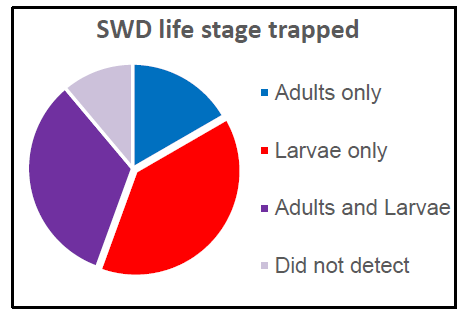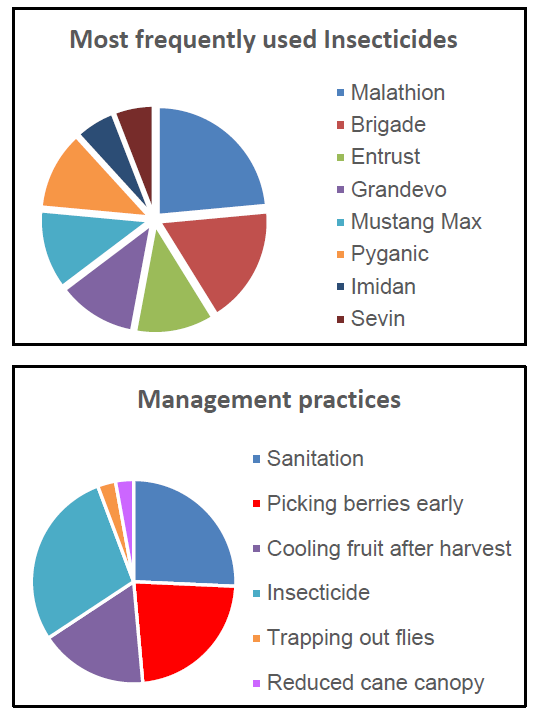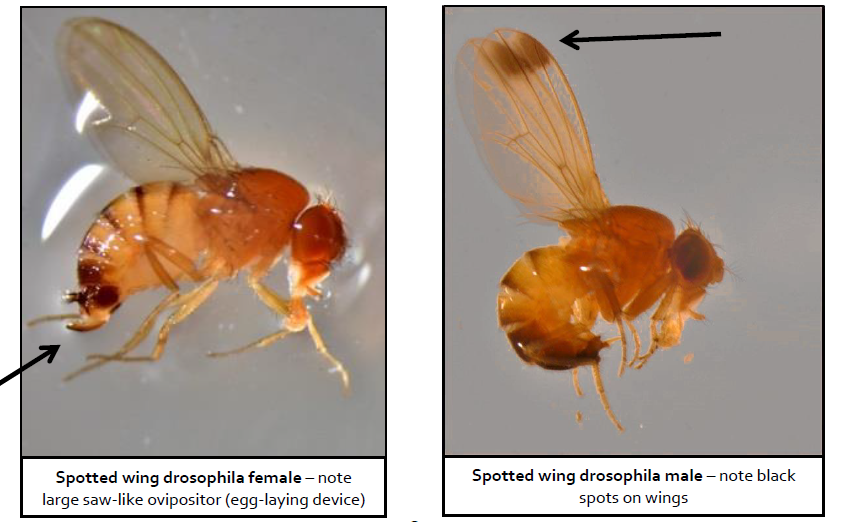Survey Summary: Spotted Wing Drosophila Survey for WI Berry Growers 2015 Season
We received 23 responses from growers in 16 different counties in Wisconsin and Illinois. The most frequently grown crops, with the greatest acreage, were strawberries, fall raspberries, and summer raspberries. Other crops grown by survey respondents include blueberries, aronia, currents and gooseberries, blackberries, black raspberries, and honeyberry.
Market and Acreage: Most survey respondents market through retail (81% of growers) and pick-your-own
(77%). Fewer respondents sell wholesale (23%) or at a market stand (5%). Only 10% of respondents are considering decreasing their berry acreage, while 42% would like to increase it and 47% plan to stay at more or less the same acreage.
Pest Pressures: The pests that growers reported as most concerning were Spotted Wing Drosophila and Tarnished Plant Bug. Thrips were considered the third most concerning. Crop loss due to SWD was estimated at between 1% to 50%, and 15 out of 21 growers (71%) indicated being “very concerned” about SWD in their berries. Only 1 grower (5%) was “not at all concerned”.

About half of respondents can identify both male and female SWD, while 28% can only ID the males. Only 22% of respondents said they cannot identify male or female SWD. Most respondents (86%) are aware that there is a winter-morph of SWD in Wisconsin.
SWD Monitoring: 80% of respondents monitored for SWD in 2015. Of those who monitored, only two (12%) did not catch any SWD. Three (18%) trapped adults only, seven (41%) trapped larvae only, and six (35%) trapped both adults and larvae.
Of those who monitored, 47% monitored while their crop was fruiting, 35% monitored throughout the season, and 25% monitored only until first detection.
First detection occurred sometime between June 30th until July 27th, depending on the farm.
SWD Management: Of those who found SWD on their farm, only 1 grower (7%) did not subsequently manage in some way for SWD.

71% of growers used an insecticide to manage SWD. The most frequently used insecticides in 2015 were Malathion (4 growers), Brigade (3 growers), Mustang Max, Entrust, Grandevo, and Pyganic (2 growers each), and Sevin and Imidan (1 grower each).
Conventional growers sprayed between 0 to 4 times in 2015, while organic growers had to spray over 5 times in 2015.
Other management practices used include sanitation (picking off damaged and/or fallen berries; 64% of respondents), picking berries early (57%), and cooling fruit after harvest (47%). Only one grower (7%) used trapping out flies as a management technique, one (7%) used reduced cane canopy, and no growers used screen exclusion or floating row cover.
55% of respondents have visited the UW SWD website, and of those that had visited 57% found it “very useful”.


